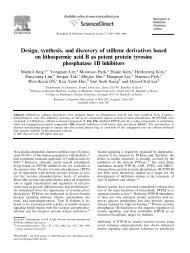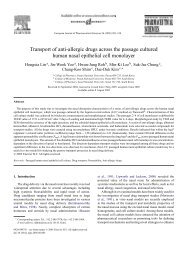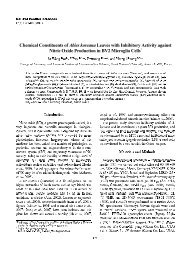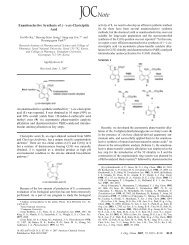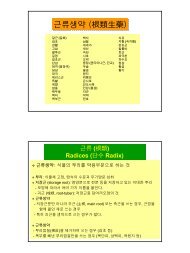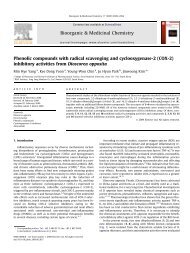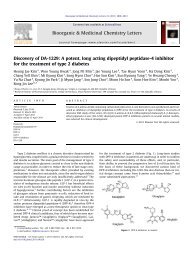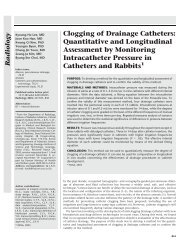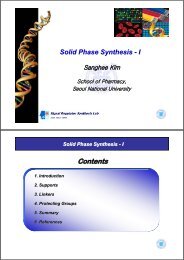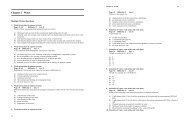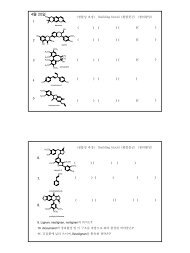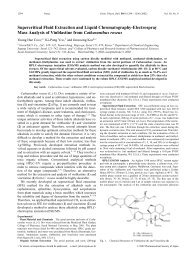Tripartin, a Histone Demethylase Inhibitor from a Bacterium ...
Tripartin, a Histone Demethylase Inhibitor from a Bacterium ...
Tripartin, a Histone Demethylase Inhibitor from a Bacterium ...
Create successful ePaper yourself
Turn your PDF publications into a flip-book with our unique Google optimized e-Paper software.
<strong>Tripartin</strong>, a <strong>Histone</strong> <strong>Demethylase</strong> <strong>Inhibitor</strong><br />
<strong>from</strong> a <strong>Bacterium</strong> Associated with<br />
a Dung Beetle Larva<br />
ORGANIC<br />
LETTERS<br />
2013<br />
Vol. 15, No. 8<br />
1834–1837<br />
Seong-Hwan Kim, † So Hee Kwon, ‡ Seon-Hui Park, † Jae Kyun Lee, § Hea-Son Bang,<br />
Sang-Jip Nam,^ Hak Cheol Kwon, # Jongheon Shin, † and Dong-Chan Oh* ,†<br />
Natural Products Research Institute, College of Pharmacy, Seoul National University,<br />
1 Gwanak-ro, Gwanak-gu, Seoul 151-742, Republic of Korea, College of Pharmacy,<br />
Yonsei Institute of Pharmaceutical Sciences, Yonsei University, Incheon, 406-840,<br />
Republic of Korea, Neuro-Medicine Center, Korea Institute of Science and Technology,<br />
P.O. Box 131, Cheongryang, Seoul 130-650, Republic of Korea,<br />
Department of Agricultural Environment, National Academy of Agricultural Science,<br />
Suwon 441-707, Republic of Korea, Department of Chemistry and Nano Science,<br />
Ewha Womans University, Seoul 120-750, Republic of Korea, and<br />
Natural Products Research Center, Korea Institute of Science and Technology,<br />
Gangneung, Gangwon-do 210-340, Republic of Korea<br />
dongchanoh@snu.ac.kr<br />
Received February 15, 2013<br />
ABSTRACT<br />
)<br />
<strong>Tripartin</strong> (1), a new dichlorinated indanone, was isolated <strong>from</strong> the culture broth of the Streptomyces sp. associated with a larva of the dung beetle<br />
Copris tripartitus Waterhouse. The planar structure of tripartin (1) was identified by the spectroscopic analyses of NMR, mass, UV, and IR data.<br />
The structure was confirmed, and the absolute configuration of 1 was determined by X-ray crystallography. <strong>Tripartin</strong> displayed specific activity as<br />
an inhibitor of the histone H3 lysine 9 demethylase KDM4 in HeLa cells.<br />
Investigation of the bacterial symbionts of eukaryotic<br />
hosts has become a powerful approach for the discovery of<br />
new chemical entities. 1 In particular, insects, the phylogenetic<br />
group with the most biodiversity on Earth, host<br />
numerous chemically prolific bacteria. 2 For example, the<br />
fungus-growing ant Apterostigma dentigerum utilizes dentigerumycin,<br />
a selective antifungal cyclic peptide produced<br />
by a Pseudonocardia symbiont, for the protection of a food<br />
† Seoul National University.<br />
‡ Yonsei University.<br />
§ Neuro-Medicine Center, Korea Institute of Science and Technology.<br />
National Academy of Agricultural Science.<br />
)<br />
^ Ewha Womans University.<br />
# Natural Products Research Center, Korea Institute of Science and<br />
Technology.<br />
(1) Crawford, J. M.; Clardy, J. Chem. Commun. 2011, 47, 7559.<br />
(2) O’Brien, J.; Wright, G. D. Curr. Opin. Biotechnol. 2011, 22, 552.<br />
fungus <strong>from</strong> a parasitic fungus. 3 The southern pine beetle<br />
Dendroctonus frontalis harbors a Streptomyces sp. in a<br />
specialized body structure, the mycangium, and controls<br />
the antagonistic fungus Ophiostoma minus to protect the<br />
larval food fungus Entomocorticium sp. with the bacterial<br />
compound mycangimycin. 4 Continuous research on identifying<br />
new bioactive compounds with novel structures<br />
<strong>from</strong> insect-associated bacteria has resulted in the discovery<br />
of a new macrocyclic lactam, sceliphrolactam, <strong>from</strong> a<br />
(3) Oh, D.-C.; Poulsen, M.; Currie, C. R.; Clardy, J. Nat. Chem. Biol.<br />
2009, 5, 391.<br />
(4) (a) Scott, J. J.; Oh, D.-C.; Yuceer, M. C.; Klepzig, K. D.; Clardy,<br />
J.; Currie, C. R. Science 2008, 322, 63. (b) Oh, D.-C.; Scott, J. J.; Currie,<br />
C. R.; Clardy, J. Org. Lett. 2009, 11, 633.<br />
(5) (a) Oh, D.-C.; Poulsen, M.; Currie, C. R.; Clardy, J. Org. Lett.<br />
2011, 13, 752. (b) Poulsen, M.; Oh, D.-C.; Clardy, J.; Currie, C. R. PLoS<br />
One 2011, 6, e16763.<br />
10.1021/ol4004417 r 2013 American Chemical Society<br />
Published on Web 04/03/2013
wasp system. 5 Additionally, a recent study on a rare<br />
actinomycete, Amycolatopsis sp., <strong>from</strong> a grasshopper resulted<br />
in the discovery of new tetrasaccharides, actinotetraoses,<br />
and a new angucycline, amycomycin A. 6 A<br />
termite-associated Streptomyces strain yielded cyclic depsipeptides<br />
with modified amino acids, microtermolides A<br />
and B. 7<br />
We have investigated the bacteria associated with the<br />
dung beetle Copris tripartitus Waterhouse in the search for<br />
new chemotypes because its system comprises extensive<br />
microbial communities that possibly originated <strong>from</strong> the<br />
feces of herbivores, which the beetle utilizes for feeding and<br />
making brood balls. 8 Our chemical investigation of the<br />
actinomycetes isolated <strong>from</strong> dung beetle brood balls led to<br />
the discovery of tripartilactam, a novel macrocyclic lactam<br />
with a cyclobutane ring with Na þ /K þ ATPase inhibition<br />
activity, 9 and the coprismycins, which are new neuroprotective<br />
phenylpyridines. 10 We continuously isolated bacteria<br />
associated with the beetle’s larvae and chemically<br />
screened the bacterial cultures. During our LC/MS<br />
chemical analysis, we identified a Streptomyces sp. (strain<br />
#SNC023) that produced a compound displaying a typical<br />
dichlorinated mass spectral pattern. We scaled up the<br />
culture of SNC023 and further investigated the compound,<br />
isolating and identifying a structurally novel dichlorinated<br />
indanone, tripartin (1).<br />
For biological evaluation of new chemotypes, we primarily<br />
focused on the histone methylation regulation<br />
system because histone methylation plays a role in biology<br />
by regulating transcription, maintaining genomic integrity,<br />
and contributing to epigenetic effects. 11 The dynamic<br />
methylation of lysine and arginine residues has diverse<br />
transcriptional outcomes, with different methylation sites<br />
and states being associated with activation or repression of<br />
transcription. The methylation of specific lysine residues is<br />
regulated by the competition of two enzymes, histone<br />
methyltransferases (HMTs) and histone demethylases<br />
(KDMs). The largest identified family of KDMs is the<br />
JmjC-domain-containing family and 2-oxoglutarate and<br />
Fe(II)-dependent oxygenase. 12 The human KDM subfamily<br />
has five members (KDM2/7, KDM3, KDM4, KDM5,<br />
and KDM6). Several KDMs are targets for the treatment<br />
(6) (a) Guo, Z. K.; Zhang, G. F.; Jiao, R. H.; Shen, Y.; Xu, Q.; Tan,<br />
R. X.; Ge, H. M. Plant Med. 2012, 78, 998. (b) Guo, Z. K.; Liu, Shou, B.;<br />
Jiao, R. H.; Wang, T.; Tan, R. X.; Ge, H. M. Bioorg. Med. Chem. Lett.<br />
2012, 22, 7490.<br />
(7) Carr, G.; Poulsen, M.; Klassen, J. L.; Hou, Y.; Wyche, T. P.;<br />
Bugni, T. S.; Currie, C. R.; Clardy, J. Org. Lett. 2012, 14, 2822.<br />
(8) Fincher, G. T. J. Georgia Entomol. Soc. 1981, 16, 316.<br />
(9) Park, S.-H.; Moon, K.; Bang, H.-S.; Kim, S.-H.; Kim, D.-G.; Oh,<br />
K.-B.; Shin, J.; Oh, D.-C. Org. Lett. 2012, 25, 1258.<br />
(10) Kim, S.-H.; Ko, H.; Bang, H.-S.; Park, S.-H.; Kim, D.-G.;<br />
Kwon, H. C.; Kim, S. Y.; Shin, J.; Oh, D.-C. Bioorg. Med. Chem. Lett.<br />
2011, 21, 5715.<br />
(11) Martin, C.; Zhang, Y. Nat. Rev. Mol. Cell. Biol. 2005, 6, 838.<br />
(12) Tsukada, Y.; Fang, J.; Erdjument-Bromage, H.; Warren, M. E.;<br />
Borchers, C. H.; Tempst, P.; Zhang, Y. Nature 2006, 439, 811.<br />
(13) (a) He, J.; Nguyen, A. T.; Zhang, Y. Blood 2011, 117, 3869. (b)<br />
Yang, J.; Jubb, A. M.; Pike, L.; Buffa, F. M.; Turley, H.; Baban, D.;<br />
Leek, R.; Gatter, K. C.; Ragoussis, J.; Harris, A. L. Cancer Res. 2010, 70,<br />
6456.<br />
(14) De Santa, F.; Totaro, M. G.; Prosperini, E.; Notarbartolo, S.;<br />
Testa, G.; Natoli, G. Cell 2007, 130, 1083.<br />
of diseases such as leukemia, breast, and prostate cancers 13<br />
and inflammation. 14 Despite extensive effort, very few<br />
KDM-selective inhibitors have been identified. 15 Among<br />
the KDMs, KDM4 (histone H3 lysine 9 demethylase)-<br />
specific inhibitors are least known. We evaluated the<br />
biological activity of tripartin as a histone H3 lysine 9<br />
demethylase KDM4 inhibitor. Here, we report the discovery<br />
of tripartin (1) including the isolation and structure<br />
elucidation and its biological activity as the first natural<br />
specific inhibitor of the histone lysine demethylase KDM4.<br />
Table 1. NMR Data for <strong>Tripartin</strong> (1) in DMSO-d 6<br />
C/H<br />
δ H<br />
a<br />
mult<br />
(J in Hz) δ C<br />
b<br />
HMBC<br />
1 201.8 C<br />
2a 3.10 d (18.9) 47.2 CH 2 1, 3, 8, 9, 10<br />
2b 2.62 d (18.9) 1, 3, 8, 9, 10<br />
3 80.2 C<br />
4 155.7 C<br />
5 6.57 d (1.8) 109.2 CH 3, 4, 6, 7, 9<br />
6 160.4 C<br />
7 6.41 d (1.8) 98.5 CH 1, 5, 6, 9<br />
8 139.2 C<br />
9 131.1 C<br />
10 6.66 s 76.7 CH 2, 3, 9<br />
a 500 MHz. b 125 MHz.<br />
The Streptomyces strain SNC023 was isolated <strong>from</strong> a<br />
larva of the dung beetle C. tripartitus. 16 The bacterium was<br />
cultivated in YPM (mannitol 4 g, yeast 2 g, and peptone 2 g)<br />
(15) (a) Chang, K. H.; King, O. N.; Tumber, A.; Woon, E. C.;<br />
Heightman, T. D.; McDonough, M. A.; Schofield, C. J.; Rose, N. R.<br />
ChemMedChem 2011, 6, 759. (b) Hamada, S.; Suzuki, T.; Mino, K.;<br />
Koseki, K.; Oehme, F.; Flamme, I.; Ozasa, H.; Itoh, Y.; Ogasawara, D.;<br />
Komaarashi, H.; Kato, A.; Tsumoto, H.; Nakagawa, H.; Hasegawa, M.;<br />
Sasaki, R.; Mizukami, T.; Miyata, N. J. Med. Chem. 2010, 53, 5629. (c)<br />
Luo, X.; Liu, Y.; Kubicek, S.; Myllyharju, J.; Tumber, A.; Ng, S.; Che,<br />
K. H.; Podoll, J.; Heightman, T. D.; Oppermann, U.; Schreiber, S. L.;<br />
Wang, X. A. J. Am. Chem. Soc. 2011, 133, 9451. (d) Rose, N. R.; Ng,<br />
S. S.; Mecinovic, J.; Lienard, B. M. R.; Bello, S. H.; Sun, Z.;<br />
McDonough, M. A.; Oppermann, U.; Schofield, C. J. J. Med. Chem.<br />
2008, 51, 7053.<br />
(16) SNC023 was isolated <strong>from</strong> chitin based agar (chitin 4 g, K 2 HPO 4<br />
0.75 g, MgSO 4 3 7H 2O 0.5 g, KH 2 PO 4 3.5 g, FeSO 4 3 7H 2O 10 mg,<br />
MnCl 2 3 4H 2O 10 mg, ZnSO 4 3 7H 2O 10 mg, agar 15 g in distilled 1 L of<br />
water) with cycloheximide. 1 g of the pulverized larvae was suspended in<br />
5 mL of distilled water. The suspension was heated at 65 °C for 5 min.<br />
From the suspension, 200 μL were spread on chitin based agar plates.<br />
From the 16S rDNA analysis, SNC023 was determined to be the most<br />
closely related to Streptomyces diastaticus (99% identity), identifying the<br />
strain as Streptomyces sp.<br />
(17) White powder, [R] 20 D 109 (c 0.05, MeOH), UV (MeOH) λ max<br />
(log ε) 217 (3.38) nm, 268 (2.77) nm, 330 (2.42) nm, IR (neat) ν max 3360,<br />
3195, 2924, 2853, 1659 cm 1 . For 1 H (500 MHz) and 13 C (125 MHz)<br />
NMR data, see Table 1, HR-CI mass spectrometry obsd [M þ H] þ at<br />
m/z 262.9873 (calcd for C 10 H 9 Cl 2 O 4 [M þ H] þ 262.9878).<br />
Org. Lett., Vol. 15, No. 8, 2013 1835
liquid medium, and the entire culture (20 L) was extracted<br />
with ethyl acetate. A dry extract was prepared after<br />
evaporating the organic solvent in vacuo. <strong>Tripartin</strong> (1) 17<br />
was isolated as a white powder <strong>from</strong> the extract by<br />
repetitive reversed-phase chromatography using a flash<br />
column and HPLC. The molecular formula of 1 was<br />
deduced as C 10 H 8 Cl 2 O 4 based on the high-resolution<br />
chemical ionization mass spectrum (obsd [M þ H] þ at<br />
m/z 262.9873, calcd [M þ H] þ 262.9878) and 1 H and 13 C<br />
NMR data. Analysis of the IR spectrum indicated the<br />
presence of hydroxy and carbonyl functionalities with IR<br />
absorption at 3360 and 1659 cm 1 , respectively.<br />
Of the eight protons in the molecular formula, the 1 H<br />
NMR spectrum showed three downfield protons (δ H 6.41,<br />
6.57, and 6.66) and two protons (δ H 2.62 and 3.10) in the<br />
aliphatic region, indicating that tripartin possesses three<br />
exchangeable protons (Table 1). Analysis of the 13 CNMR<br />
spectrum revealed one ketone carbon (δ C 201.8), six sp 2<br />
carbons (δ C 160.4, 155.7, 139.2, 131.1, 109.2, and 98.5),<br />
and three sp 3 carbons (δ C 80.2, 76.7, and 47.2). The<br />
1 H 13 C one-bond correlations in the gHSQC spectrum<br />
showed that the protons at 6.57 and 6.41 ppm were directly<br />
connected to the double-bond carbons at 109.2 and 98.5<br />
ppm, respectively. The singlet proton at 6.66 ppm correlated<br />
with the carbon at 76.7 ppm in the gHSQC spectrum,<br />
indicating that this carbon is possibly dichlorinated. The<br />
1 H 1 H COSY spectrum provided a long-range coupling<br />
between the two protons at δ H 6.57 and 6.41, with a small<br />
coupling constant of 1.8 Hz, a typical meta coupling in an<br />
aromatic ring system. Further analysis of the gHMBC<br />
correlations led to the construction of the dihydroxy<br />
aromatic ring based on the heteronuclear coupling <strong>from</strong><br />
H-5 (δ H 6.57) to C-3, C-4, C-6, C-7, and C-9 and <strong>from</strong> H-7<br />
(δ H 6.41) to C-1, C-5, C-6, and C-9 (Figure 1). The<br />
particularly large geminal coupling constant (18.9 Hz)<br />
between the two protons at C-2 indicated that this methylene<br />
belongs to a five-membered ring system. 18 In addition,<br />
the key HMBC correlations <strong>from</strong> H 2 -2 to C-1, C-3, C-8,<br />
C-9, and C-10 connected the five-membered ring with a<br />
ketone to the aromatic ring, constructing an indanone<br />
skeleton. The dichlorinated C-10 was connected to C-3<br />
by the HMBC couplings between H-10 and C-3, C-2, and<br />
C-9, completing the planar structure of the dichlorinated<br />
indanone tripartin (1) (Figure 1).<br />
To confirm the planar structure of tripartin (1) and<br />
determine the absolute configuration of the only stereogenic<br />
center at C-3, we attempted to crystallize 1 for singlecrystal<br />
X-ray diffraction analysis. Fortunately, we were<br />
successful in crystallizing 1 in diethyl ether/methanol to<br />
yield a single and platelet crystal, which diffracted as a<br />
triclinic system. Based on the crystallographic analysis, the<br />
absolute configuration of C-3 was determined to be 3S<br />
(Figure 2).<br />
The indanone structure is often found in various natural<br />
sources. For example, afzeliindanone was isolated <strong>from</strong><br />
(18) Pretsch, E.; B€uhlmann, P.; Affolter, C. Structure Determination<br />
of Organic Compounds-Tables of Spectral Data; Springer: New York,<br />
2000; p 176.<br />
Figure 1. Key HMBC correlations of tripartin (1).<br />
the roots of Uvaria afzelii plants, and pterosin class<br />
compounds were reported <strong>from</strong> Pteris semipinnata. 19 Nodulisporin<br />
C was reported to be a secondary metabolite of<br />
the fungus Nodulisporium sp., which is associated with<br />
Juniperus cedre. 20 In addition, an indanone (1-methoxy-6-<br />
methyl-3-oxo-2,3-dihydro-1H-indene-4-carbaldehyde) was<br />
discovered <strong>from</strong> the marine cyanobacterium Lyngbya<br />
majuscula. 21<br />
Figure 2. ORTEP diagram for tripartin (1).<br />
However, to our best knowledge, tripartin is the first<br />
indanone compound isolated <strong>from</strong> actinomycete bacteria.<br />
The dichlorine functionality is unique; thus, tripartin is the<br />
first dichlorinated example of the indanone class of natural<br />
products. <strong>Tripartin</strong> (1) could be biosynthesized by adding<br />
and cyclizing acetate-derived precursors. The two chlorine<br />
atoms at C-10 are possibly introduced through a flavindependent<br />
halogenase, which was proposed to produce a<br />
dichlorinated acetate unit incorporated in chloramphenicol<br />
<strong>from</strong> Streptomyces venezuleae (Figure S6). 22 However,<br />
the biosynthetic chlorination mechanism should be further<br />
studied to exclude the alternative nonheme iron halogenation,<br />
which introduces chlorine atoms into the sp 3 carbon<br />
of leucine, as shown for barbamide biosynthesis. 23<br />
(19) (a) Okpekon, T.; Millot, M.; Champy, P.; Gleye, C.; Yolou, S.;<br />
Bories, C.; Loiseau, P.; Laurens, A.; Hocquemiller, R. Nat. Prod. Res.<br />
2009, 23, 909. (b) Kuroyanagi, M.; Fukuoka, M.; Yoshihira, K.; Natori,<br />
S. Chem. Pharm. Bull. 1974, 22, 2762.<br />
(20) Dai, J.; Krohn, K.; Fl€orke, U.; Draeger, S.; Schulz, B.; Szikszai,<br />
A. K.; Antus, S.; Kurtan, T.; Ree, T. V. Eur. J. Org. Chem. 2006, 15,<br />
3498.<br />
(21) Nagle, D. G.; Zhou, Y.-D.; Park, P. U.; Paul, V. J.; Rajbhandari,<br />
I.; Duncan, C. J. G.; Pasco, D. S. J. Nat. Prod. 2000, 63, 1431.<br />
(22) Podzelinska, K.; Latimer, R.; Bhattacharya, A.; Vining, L. C.;<br />
Zechel, D. L.; Jia, Z. J. Mol. Biol. 2010, 397, 316.<br />
1836 Org. Lett., Vol. 15, No. 8, 2013
Figure 3. Effect of tripartin (1) on various histone H3 lysine<br />
methylation and acetylation. HeLa cells were treated with 0.1%<br />
DMSO (control) or 10 μMof1, as indicated. After 24 h, histones<br />
extracted <strong>from</strong> HeLa cells were resolved on a 15% SDS-polyacrylamide<br />
gel. Immunoblotting was performed with antipan<br />
histone H3, anti-H3K9me3, anti-H3K9me2, anti-H3K3me1,<br />
anti-H3K27me3, anti-H3K4me3, anti-H3K36me3, anti-H3K79me2,<br />
and anti-H3ace.<br />
To test whether tripartin (1) is a potent and highly<br />
selective KDM4 inhibitor, we examined the ability of<br />
tripartin to inhibit KDM4 in HeLa cells by immunoblot<br />
analysis of extracted histone using antibodies specific for<br />
methylated H3K9. Treatment of HeLa cells with tripartin<br />
(10 μM) led to a substantial increase in global H3K9me3<br />
levels, which signifies the accumulation of methylated<br />
lysine by inhibition of the demethylation process of<br />
KDM4 (Figure 3). KDM3 specifically demethylates<br />
H3K9me2/1, 24 the levels of which were not increased by<br />
tripartin. Thus tripartin is not an inhibitor of KDM3.<br />
<strong>Tripartin</strong> did not influence the methylation of other lysines<br />
such as Lys 27, Lys 4, or Lys 36. Because KDM6, KDM5,<br />
and KDM2/7 demethylate histone H3 Lys 27, Lys 4, and<br />
Lys 36 respectively, this result suggests that tripartin does<br />
not inhibit KDM6, KDM5, or KDM2/7. Even though a<br />
demethylation enzyme of histone H3 Lys 79 has not been<br />
identified yet, we measured the methylation level of<br />
H3K79me2 for a further specificity test. In this assay,<br />
tripartin did not change the methylation level of<br />
H3K79me2. Additionally, tripartin did not affect histone<br />
H3 acetylation (H3ace in Figure 3). These results strongly<br />
(23) (a) Fujimori, D. G.; Walsh, C. T. Curr. Opin. Chem. Biol. 2007,<br />
11, 553. (b) Galonic, D. P.; Vailancourt, F. H.; Walsh, C. T. J. Am.<br />
Chem. Soc. 2006, 128, 3900.<br />
(24) Rotili, D.; Mai, A. Genes Cancer 2011, 2, 663.<br />
(25) Sakurai, M.; Rose, N. R.; Schultz, L.; Quinn, A. M.; Jadhav, A.;<br />
Ng, S. S.; Oppermann, U.; Schofield, C. J.; Simeonov, A. Mol. Biosyst.<br />
2010, 6, 357.<br />
suggest that tripartin (1) can specifically inhibit histone<br />
H3 lysine 9 demethylase (KDM4).<br />
<strong>Inhibitor</strong>s of KDMs, which are the most recently discovered<br />
families of histone demethylases, are extremely<br />
rare. 24 Only a few KDM-selective inhibitors such as N-<br />
oxalylglycine, disulfiram, ebselen, and N-oxalyl-D-tyrosine<br />
derivatives have been identified <strong>from</strong> synthetic libraries. 13<br />
Screening of small compound libraries provided quercetin<br />
as a KDM inhibitor. 25 However, quercetin, a natural<br />
flavonoid, was determined to be a promiscuous inhibitor.<br />
<strong>Tripartin</strong> (1) is the first natural product that exhibits<br />
specific inhibitory activity toward KDM4 as one of the<br />
rare KDM inhibitors.<br />
We also investigated the cytotoxicity of 1 against various<br />
cancer cell lines such as HeLa, SNU638, A549, HCT116,<br />
K562, MDA-MB231, and SK-HEP-1. However it displayed<br />
no significant activity. We also evaluated tripartin’s<br />
bioactivity using in vitro antibacterial assays but could not<br />
find significant inhibitory activity against the pathogenic<br />
bacteria Staphylococcus aureus, Bacillus subtilis, Micrococcus<br />
luteus, Proteus vulgaris, Salmonella typhimurium,<br />
and Escherichia coli. Usingin vitro antifungal assays, tripartin<br />
did not inhibit Candida albicans, Aspergillus fumigatus,<br />
Trichophyton rubrum, andTrichophyton mentagrophytes.<br />
Additionally, we tested the inhibitory activity<br />
of tripartin against amyloid-β42 aggregation related to<br />
Alzheimer disease 26 but found no significant activity.<br />
In conclusion, we identified a structurally novel dichlorinated<br />
indanone, tripartin, as a specific histone H3 lysine 9<br />
demethylase (KDM4) inhibitor, <strong>from</strong> the culture broth of<br />
a Streptomyces sp. associated with a larva of the dung<br />
beetle Copris tripartitus. The discovery of this new chemotype<br />
with interesting biological activity highlights that<br />
microorganisms in insect symbiotic systems are a promising<br />
niche for exploring undiscovered natural chemical<br />
diversity.<br />
Acknowledgment. This work was supported by the National<br />
Research Foundation of Korea (NRF) grants<br />
funded by the Korean government (MEST) (No. 2011-<br />
0015931).<br />
Supporting Information Available. Experimental methods,<br />
1 H, 13 C, and 2D NMR spectra, X-ray crystallography<br />
data of 1, and phylogenetic analysis of the bacterium<br />
SNC023. This material is available free of charge via the<br />
Internet at http://pubs.acs.org.<br />
(26) Askanas, V.; Engel, W. K. Curr. Opin. Rheumatol. 2003, 15, 737.<br />
The authors declare the following competing financial interest(s): We<br />
are preparing a patent application on tripartin.<br />
Org. Lett., Vol. 15, No. 8, 2013 1837



